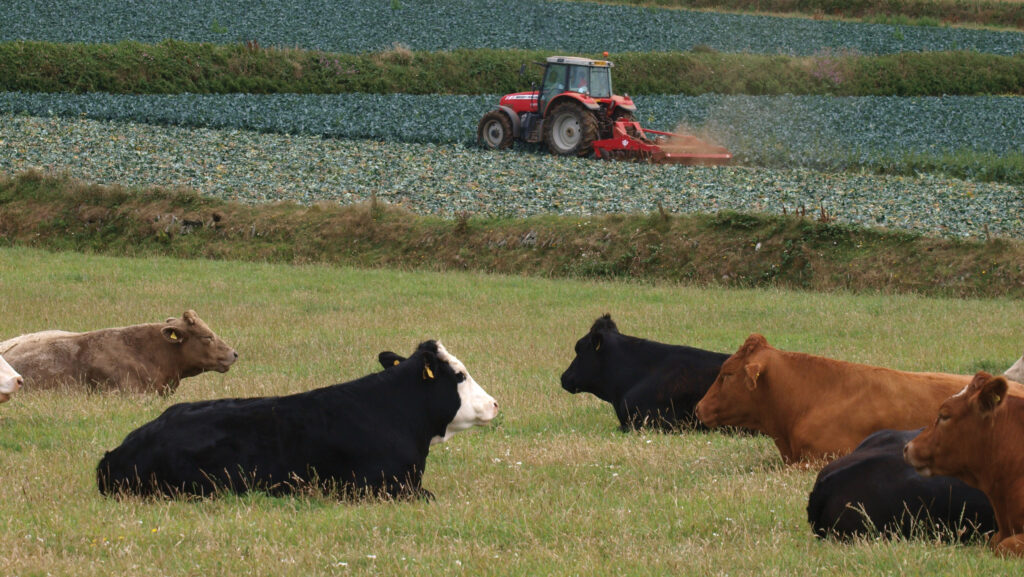How improved cashflow planning can deliver many benefits
 © Nik Taylor/Alamy Stock Photo
© Nik Taylor/Alamy Stock Photo The prospect of the Basic Payment Scheme (BPS) for all English farms falling to just £600 next year should sharpen the need for budgeting and cashflow planning, say advisers.
At Adas, assistant technical director Tony Turner sees 60ha to 240ha family farms as generally the most vulnerable.
Among those, the arable sector looks most under pressure, he says.
The timing of expenditure and accurate cashflow monitoring will become more important because of the cash squeeze created by the loss of BPS.
See also: Advice on managing borrowings and their costs
The higher cash values that beef and sheep producers have been receiving for stock mask some of the loss of direct support, says Tony.
While feed prices have not soared, other input costs, including labour, have risen significantly and the cost of replacements and youngstock is high.
Talk to the bank
Although not a new message, he encourages farmers to develop better relationships with their banks, essentially by keeping them in touch with what’s happening, having identified likely bumps in the cashflow road.
“Work with your lender so they understand the position and things can be pre-empted by talking – normally the banks are very good, but they don’t like surprises,” says Tony.
“The more you plan, the better position you will be in to make decisions.
“There are solutions out there, for example in both beef and pigs by reducing risk in an integrated beef scheme or B&B pigs.
“But unless you know where you are and what the coming year looks like in cashflow terms, you’re not in a position to make an informed choice.”
For one 60ha arable farm, Tony advised switching for the 2025 harvest from three crops – oilseed rape, wheat and barley – to one, which was barley.
This has simplified things significantly, in terms of operations, management and contractor costs.
Attention to detail
Knowing where you are in the market is important.
One example of that is beef finishers, who weigh their cattle every week so they know exactly where they are in terms of making the grades and having the information they need to be able to tweak rations, says Tony.
A 12-month cashflow prediction is the most useful because of the volatility in markets and the weather, he says, with this carefully monitored and adjusted to reflect what is happening in the business.
He suggests the following to help with budgeting and cashflow prediction:
- Know at any one time how much the business owes, who it is owed to, and when it is due. This might seem obvious, but there is a tendency to remember the big items such as rent but be less clear about other creditors
- Be realistic – whether on expectations of crop yields or other technical performance. For example, scanning percentages – go on what is realistic for the farm’s past performance and the year
- Keep on top of actual stock numbers
- HP, loans and other financial agreements: what payments are due when, and when do they end? One option is to restructure loans to give a longer payment term but freeing up significant monthly cash amounts
- Where possible, use the discipline of putting a sum aside each month into a tax fund so that when the tax bill has to be paid, much of it can come from this account
- Get annual accounts in as soon as possible after the end of the tax year, to help with planning
- Grants are useful, but 100% of the cash has to be found up front for the kit, and the grant payment then claimed. “Experience with the Future Farm Resilience Fund advice tells us that some grant-aided items have been delayed because sufficient funds have not been available,” says Tony.
Importance of timely accounts
Getting annual accounts completed as soon as possible after the year end helps on several fronts, says Kate Bell, a partner at accountant Albert Goodman.
The more timely the accounts, the more meaningful they are and will enable better planning for the business, for tax liabilities and to reduce payments on account when profits fall.
For partnerships, especially where profits fluctuate, it can also help with decisions on profit shares.
It can also assist with the decision whether to use farmers’ averaging for profit reporting, which is increasingly being used.
“Averaging is hugely valuable, especially if you are balancing between higher and basic rates of tax,” says Kate.
“It can reduce the tax rate paid and therefore the bill – and even if it doesn’t, it can help the cashflow.
“If you’re averaging backwards, this can also help legitimately reduce payments on account, avoiding interest.
“Where the cash starts and finishes in any year is one thing, but where the overdraft peaks is the key,” says Kate.
In a similar vein to Tony’s recommendation of a tax fund, she says depreciation should be accounted for.
“Depreciation is only a paper figure and has no meaning for tax or cash, but in theory you need to spend at least the depreciation amount in order to keep the farm well-equipped and up to date.”
Underestimates warning
Some items get missed out of cashflows or underestimated, says Kate.
On dairy farms, a classic in this regard is sundries – mainly chemicals, which are increasingly expensive and can represent a significant sum.
“And don’t forget the annual 1% arrangement fee for the overdraft. It happens every year but can easily be missed out of the budget and cashflow.”
Funding expansion

© Adobe Stock
Where budgets and cashflows are being drawn up for a business to expand, consider timescales, says Kate.
For example, taking on an extra 40ha of arable ground next door will require funding for longer than a season, when inputs, storage and rent are accounted for, with the following crop often having to be funded before you have sold the first one.
“It ties up a lot of cash and shouldn’t be underestimated,” she says.
Farming businesses need to calculate what profit is needed to keep up with monthly cash requirements and achieve the businesses’ aims, says Kate.
“Some are surprised at how high it might need to be, but when all the farming and personal expenses and commitments are included, that’s what they have to hit.”
Know your personal expenditure
Many farmers draw a cash sum weekly or monthly but don’t calculate their actual cost of living, which can be a sobering amount, say Tony and Kate.
Monthly drawings of £500 or so may be taken, but personal and household expenditure will be far more than this and is often hidden by standing orders used for telephone bills, heat and light, council tax, water and even daily papers.
Many of these items will be apportioned between private and business use, so if a cashflow is being drawn up based on the numbers in the accounts, remember that this may not be the true cost and you need to go to the bank statements to get to the total, advises Kate.
Further items that will be apportioned include vehicle costs and vet bills, the latter to distinguish between farm animals, working animals and leisure or pet animals that cannot be justified as a business expense.
School fees are another area which adds significantly to the personal expenditure total for some.
Careful exit planning
When a business is winding down, cashflow and tax have to be considered.
“The sale of machinery on which capital allowances have been claimed over the years can lead to a very hefty tax charge, known as balancing charge,” warns Kate.
This calls for careful exit planning, even if the plan is to carry on farming by using contractors.
“Also, there is no ability to average in the final year,” she points out.
She reminds farmers that an election to use the herd basis of accounting means the income from a final sale or significant disposal while still in business is tax free.
This applies only to certain stock, including breeding herds or flocks, and includes horses kept for breeding.
